Plants That Could Save Your Life Part 2
Part 2 in a series of forage plants that have medicinal and nutritional properties
Let me begin Part 2 in the series of plants that can be useful in your preparations to be prepared for the unknown, by saying many people are turning back to the ways of our country’s original inhabitants, the Native American’s. As many people are losing their faith in modern medicine, many people are turning to the homeopathic ways many of our own ancestors who brought with them to this country the remedies used for generations past.
I do not have a degree in medicine, but as a family we actively engage in using many natural and organic remedies that have proven to be useful when raising my own family. Some of these, which were handed down from my own mother and her ancestors. My son has done extensive research on controlling his allergies and asthma through strict discipline eating only certain foods and of course, exercise.
This information I am sharing is purely information that you can apply to your own lives, and you alone are the only one who can determine what is right for you or your family. Remember, God created all living things, and it is up to the individual to make the choice. All life and nature have a purpose, and writing this series, I am only providing you another source of information as a guide.
Start by identifying the common wild edibles in your own yard or in local parks and botanical gardens. Use a guidebook to be sure of proper identification by using pictures and physical characteristics, if you do not have firsthand knowledge of the plant. Take along a field guide whenever possible.
Scientists have catalogued over 20,000 edible plants, yet most people eat less than 20 different species. In today’s tumultuous world, a knowledge of wild foods could be important to survive.
Part 2: Natural Sources of Vitamins & Minerals
Of the forty or so different vitamins, the human body absolutely requires sufficient intake of about a dozen them in or order to prevent such debilitating conditions as Beriberi, Pellagra, Scurvy, and Rickets and it requires the intake of certain minerals to enable the body to continue functioning properly. Fortunately, Vitamin D (prevents rickets) is synthesized whenever the skin is exposed to sunlight and Vitamin K (contracts muscles) can be synthesized by bacteria in the digestive tract. But the other essential vitamins and minerals such as Vitamin A (necessary for eye health) must be obtained from the foods we eat.
Beriberi is caused by a lack of thiamine (aka vitamin B1)
Pellagra is caused by a lack of niacin (aka vitamin B3)
Scurvy is caused by a lack of ascorbic acid (aka vitamin C)
Rickets are caused by a lack of calciferol (aka vitamin D2) and cholecalciferol (aka vitamin D3)
Vitamins
Vitamins are chemical compounds that are essential to the proper functioning of the human body and preventing illness and there are about a dozen which are essential to good health in humans.
Minerals
Minerals are elements such as iron, potassium, calcium, phosphorus, and iodine that the human body requires to function properly. For instance, calcium is needed to create, repair, and strengthen bones and teeth, potassium is needed to contract muscles (including your heart), and iodine is needed to make thyroid hormones for healthy growth and development.
(Curly) Dock (Leafy vegetable)
Value As a Forage Food - The Dock plant (Rumex spp.) is a green, leafy, flowering, weed that is abundant throughout North America and is easy to identify. Also, its greens are high in vitamins and minerals A, E, C, K, iron, magnesium, manganese, calcium, folic acid, carotenoids, and Omega 3 fatty acids. In addition, they are high in fiber which helps to keep your digestive system working properly and, they contain antioxidants which help prevent cell damage and cell mutations.
Where it Can Be Found Naturally:
The many different species Dock plant are quite common throughout North America except in desert regions. Curly Dock (Rumex crispus) is one of the best-known species and it is also one of the most abundant. In addition, Dock has a distinct preference for open, sunny, areas, and moist, cultivated, or disturbed soils such as pastures, fallow fields, field edges, and fence rows. Thus, highly productive agricultural regions will always have a high density of Dock available.
How to Identify it:
Curly Dock is a perennial that grows to a height of 1 ft. to 5 ft., and which produces a rosette of large, long, slim, lance-shaped, green, leaves up to 20 in. in length with distinctly wavy edges (aka "crisped" by botanists). In addition, as the plant matures, it produces a long, slim, cone- shaped, flowering, stalk upon which green flowers bloom. Also, it should be noted that there are several different species of the Dock plant in North America and, although all species of the Dock plant (Rumex) are edible, their taste ranges from highly palatable to extremely bitter with a slightly lemony taste.
How it Should Be Prepared
The leaves of the Dock plant are the most often eaten part of the plant, and they are prepared either in a salad as a green vegetable similar to lettuce or steamed or stewed and eaten as a green similar to spinach or mustard. Also, because the flavor of this plant varies so widely, it should be noted that there is a technique that you can employ to ensure that you are harvesting a palatable species of Dock. So, assuming that you are looking at a Dock plant (Rumex), look for long, narrow, leaves with a smooth surface texture and no red or purple anywhere on the leaf, midvein, or petiole. Also, look for the lightest green petiole. Then, sample a portion of the leaf before harvesting. Note: Dock leaves are best harvested in the spring when the leaves are still curled into a tube.
How it Should Be Stored
Wild, green, leafy, vegetables cannot be preserved for long periods without modern refrigeration unless they are canned.
Can You Grow it in Your Garden?
Yes, the Dock plant can be cultivated in gardens and flowerbeds throughout the lower 48 states provided that it is given the correct soil and light conditions. For instance, Dock has a distinct preference for open, sunny, areas, and moist, cultivated, or disturbed soils and thus, it does well in well light, freshly tilled, flower beds and gardens with well-drained soil. Curly Dock
Amaranth (Leafy vegetable)
Value As a Forage Food
The Amaranth plant (Amaranthus spp.) is a green, leafy, flowering, weed that is abundant throughout North America and is easy to identify. Also, its greens are high in vitamins and minerals A, E, C, K, iron, magnesium, manganese, calcium, folic acid, carotenoids, and Omega 3 fatty acids. In addition, they are high in fiber which helps to keep your digestive system working properly and, they contain antioxidants which help prevent cell damage and cell mutations.
Where it Can Be Found Naturally
Amaranth ranges throughout North America and has a distinct preference for open, sunny, areas, and moist, cultivated, or disturbed soils such as pastures, fallow fields, field edges, and fence rows. Thus, highly productive agricultural regions will always have a high density of Amaranth available.
How to Identify it
The Amaranth plant is an annual that can grow to a height of 8 ft., and which displays green, ovate, lanceolate, spoon-like, or diamond-shaped leaves with non-serrated, wavy, edges usually measuring 2 in. to 5 in. in length. In addition, they also display spinney or bristly spikes or spike- like clusters at the ends of their ends of their branches that range from 2 1/2 inches to 12 inches in length which makes them easy to identify. Also, it should be noted that there are just under forty species of Amaranth in North America and, although all species of the Amaranth plant (Amaranthaceae) are edible, their taste ranges from highly palatable to extremely bitter.
How it Should Be Prepared
Both the leaves and stems of the Amaranth plant are eaten and, although the leaves can be eaten in a salad as a green vegetable similar to lettuce, the leaves and tender portions of the stem are usually steamed or boiled and eaten as a green similar to spinach or mustard. In addition, it should be noted that the dried seeds of the Amaranth plant have been used as a grain by many indigenous peoples. To harvest Amaranth seeds, wait until late summer or early fall after the plants have produced their seeds and began to die and then grasp the seed head with your hand and rub the seeds off, catching them in a container. Then, after the seeds have dried completely, they will need to be rubbed again to loosen the husks and then winnowed to remove the chaff. Amaranth
How it Should Be Stored
Wild, green, leafy, vegetables cannot be preserved for long periods without modern refrigeration unless they are canned.
Can You Grow it in Your Garden?
Yes, the Amaranth plant can be cultivated in gardens and flowerbeds throughout the lower 48 states provided that it is given the correct soil and light conditions. For instance, Amaranth has a distinct preference for open, sunny, areas, and moist, cultivated, or disturbed soils and thus, it does well in well light, freshly tilled, flower beds and gardens with well-drained soil.

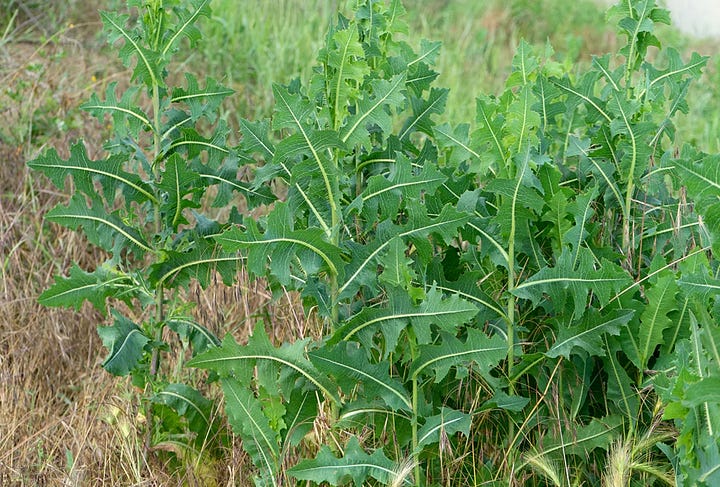
Wild Lettuce (Leafy vegetable)
Value As a Forage Food
The Wild Lettuce plant (Lactuca canadensis) is a green, leafy, flowering, perennial that is abundant throughout North America and is easy to identify. Also, its greens are high in vitamins and minerals A, E, C, K, iron, magnesium, manganese, calcium, folic acid, carotenoids, and Omega 3 fatty acids. In addition, they are high in fiber which helps to keep your digestive system working properly and, they contain antioxidants which help prevent cell damage and cell mutations.
Where it Can Be Found Naturally
Both common species of the Wild Lettuce plant (L. canadensis and L. biennis) are found throughout North America in wooded regions where the soil has been disturbed. Also, they are commonly found in forested river bottoms, adjacent to roads and trails, along the edges of woods, and in shaded, fallow, fields.
How to Identify it
Wild Lettuce (aka Yellow Lettuce) is a biennial that grows to a height of approximately 3 ft., and which produces a rosette of large, long, slim, lance-shaped, green, leaves up to 10 in. in length with distinctly lobed edges. Also, as the plant matures, it produces a dandelion-like head from which the flowers bloom. In addition, all parts of the plant turn light orangish brown upon exposure to the air. Lastly, it should be noted that there are several different species of the Wild Lettuce plant throughout North America and that the leaves of this plant appear very similar to the Dandelion plant (which is edible as well). Wild Lettuce
How it Should Be Prepared
The leaves of the Wild Lettuce plant are the most often eaten part of the plant and, when harvested at the correct stage, there is no other wild green that more closely resembles the taste of cultivated Romaine lettuce. Thus, they are most often prepared as a salad green similar to lettuce. Therefore, look for clusters of light, green, upright, leaves in the late spring or early summer because they become increasingly less palatable as they mature.
How it Should Be Stored
Wild, green, leafy, vegetables cannot be preserved for long periods without modern refrigeration unless they are canned.
Can You Grow it in Your Garden?
Yes, the Wild lettuce plant can be cultivated in gardens and flowerbeds throughout the lower 48 states provided that it is given the correct soil and light conditions. For instance, Wild Lettuce has a distinct preference for open, sunny, areas, and moist, cultivated, or disturbed soils and thus, it does well in well light, freshly tilled, flower beds and gardens with well-drained soil.
Trout Lily (Bulb)
Value As a Forage Food
The Trout Lily plant (Erythronium spp.) is a green, leafy, flowering vine that is abundant throughout North America and is easy to identify. Also, its bulbs are high in both sugars and starches (depending on the time of year they are harvested) which the human body converts to carbohydrates.
Where it Can Be Found Naturally
Trout Lily is widespread throughout the U.S. and Canada and is found in areas with rich, moist, soil. Therefore, it grows abundantly in the Eastern Woodlands, the Rocky Mountains, the Pacific states, and the wetter parts of the Great Plains. The eastern species are typically found in mature hardwood forest and the flood plains of creeks and small rivers. However, the western species are found in hardwood forests at lower elevations, in open woodlands at higher elevations, in alpine meadows, and on talus slopes.
How to Identify it
Trout Lily is a spring ephemeral (meaning that is usually gone by mid-summer) flowering plant that displays one or two basal leaves that typically measure 3 in. to 7 in. in length and 1 in. to 2 1/2 in. wide with a conspicuous crease running down the center. Also, it displays non-serrated, lanceolate or elliptical shaped, dull green, leaves that taper at both ends. In addition, when the leaves first emerge, they display mottled, curvy, grayish-purple, spots and streaks (hence the name Trout Lily) which fade as the leaves mature. Last, non-flowering plants typically have only one leaf whereas flowering plants typically have two. When it finally flowers, it produces a single blossom on a scape that measures 4 in. to 8 in. in length which grows directly from the base of the plant and it produces either white or yellow flowers with six, strongly recurved, petals with conspicuously protruding stamens and the scape takes a sharp turn at the top such that the flower either faces sideways or hangs slightly downward. The bulbs are teardrop-shaped and are about the size of a human fingernail (appear similar to a scallion or a wild onion) with a brownish coloring on the outside and a thin skin that peels off to reveal a white interior like an onion.
How it Should Be Prepared
Both the leaves and the bulbs of the Trout Lily plant (Erythronium spp.) are edible but, it should be noted that the Iroquois Indians used the leaves of this plant to prevent conception and consumption of the leaves may be responsible for miscarriages in pregnant mothers. However, the bulbs are a rare delicacy in the vegetable world people who try them for the first time often comment that it is the best tasting vegetable they have ever eaten. But, it should also be noted that when harvested in the early in the spring, they are tender, sweet, and crunchy because they contain large quantities of sugars yet, when harvested in the fall, they are harder and starchy tasting instead of being sweet because the plant has converted its sugars to starches. Thus, they are usually eaten raw if harvested in the spring and either steamed, boiled, or sautéed in butter if harvested in the fall.
How it Should Be Stored
Wild tubers are best eaten fresh but, they can be stored for short periods in a dark, cool, dry place (such as a root cellar). However, they have a tendency to wither as they dehydrate. Therefore, to prevent dehydration, it is wise to place them in a buck of moist (not wet) sand and then place the bucket in a cool, dark, dry place.
Can You Grow it in Your Garden?
Yes, the Trout Lily plant can be cultivated in gardens and flowerbeds throughout the lower 48 states provided that it is given the correct soil and light conditions. For instance, Trout Lilies require partial shade and thrive beautifully in cool woodland settings but do very poorly in hot, semi-arid, or arid locations. However, if you lack a woodland garden, then they will grow in flower beds as long as they are kept reasonably cool and provided with dappled sunlight. To successfully plant trout lily in the garden, plant them in early fall in moist, but well-drained, humus-rich, soil and place the base of the bulb 3 inches below the surface (may require a depth up to 6 inches in colder climates) and space them 5 to 6 inches apart if you’re planting them in clumps. Last, Trout Lily tubers multiply each year and can be propagated by removing the small tubers from the ground and dividing them as part of your Trout Lily plant care. Trout Lily Medicinal Uses
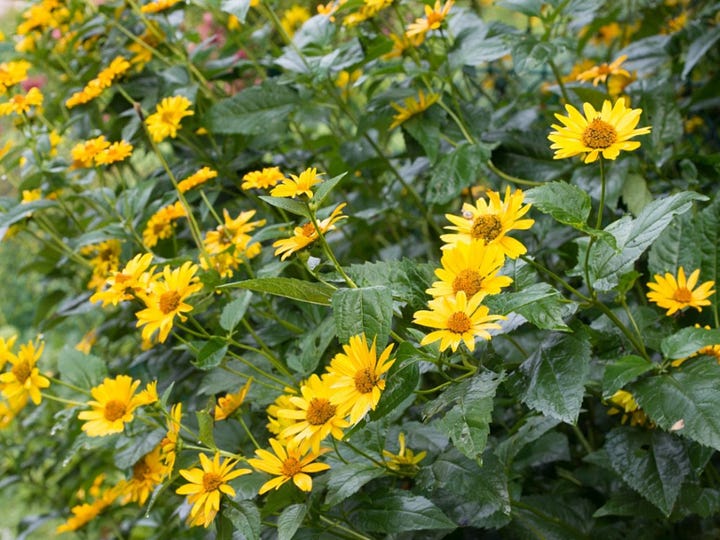

Jerusalem Artichoke (Tuber)
Value As a Forage Food
The Jerusalem Artichoke (Helianthus tuberosus) is one of the best-known wild vegetables in North America and it appears as a green, leafy, flowering, weed that is abundant throughout the U.S and is easy to identify. Also, its tubers are high in starches/sugars which the human body converts to carbohydrates. Note: Jerusalem artichoke also provides you with Thiamin, Iron, Phosphorus, Potassium.
Where it Can Be Found Naturally
Jerusalem Artichoke is widespread in North America east of the Mississippi River and it ranges from southern Canada to the Gulf of Mexico and from the Great Plains to the East Coast. However, it is most abundant in the center of this range and can be found as an escaped or introduced species in parts of the western U.S. Like most wild tubers, the Jerusalem Artichoke prefers to grow in sandy river bottoms, floodplains, lake edges, creek sides, and wet areas where there is plenty of sunlight and where the soil is sand, loamy sand, or sandy loam. Note: Commonly found growing adjacent to Hopniss.
How to Identify it
The Jerusalem Artichoke is a member of the Sunflower family, and they are tall, green, leafy plants with a single, straight, round, unbranched (except occasionally near the top), stalk, usually measuring 1/2 in. to 3/4 in. in diameter which is covered with short, stiff, raspy, hairs which remain after the plant dies in the fall. Also, the leaves of the Jerusalem Artichoke commonly measure 4 inches to 10 inches in length and are spear-shaped with finely serrated edges, display a distinct crease down the center, and are covered with the same, short, stiff, raspy, hairs as the stem. Also, they display a two, prominent, secondary veins on each side of the midvein originating at the base but stopping at the midpoint to form a distinct "u" shape. In addition, the leaves on the lower section of the stalk are positioned opposite but are sometimes positioned alternate near the top. Furthermore, they produce large flower heads the usually measure 2 inches to 3 inches in diameter which look like miniature sunflowers except that the discs in the center are yellow instead of black and are much smaller. Also, each plant produces four to eight of these flowers in a loose group. The tuber of the Jerusalem Artichoke usually measures 2 inch to 5 inches in length and are produced at the end of horizontally spread rhizomes radiating from the stalk. In addition, the tuber has a smooth skin with except for constriction rings and is gray, light brown, or cream in color but which sometimes display a reddish hue.
How it Should Be Prepared
Jerusalem Artichoke can be dug at any time of the year but, they are not fully ripe until late fall, winter, or early spring; harvested at any other time of the year, they will be hard, bitter, and full of the indigestible starch inulin. Also, they are quite famous for causing extreme flatulence when ingested before the advent of cold weather causes them to convert their starches to simple sugars. Therefore, they should not be consumed during the late spring through early fall months. Also, because of their flatulent properties, they should be cooked for one to six hours (depending on the time of year they are harvested) to convert any inulin they contain to simple sugars before consumption and they can be cooked by either steaming, boiling, or baking. Last, they have a highly palatable, almost buttery, flavor.
How it Should Be Stored
Wild tubers are best eaten fresh but, they can be stored for short periods in a dark, cool, dry place (such as a root cellar). However, they have a tendency to wither as they dehydrate. Therefore, to prevent dehydration, it is wise to place them in a buck of moist (not wet) sand and then place the bucket in a cool, dark, dry place.
Can You Grow it in Your Garden?
Yes, the Jerusalem Artichoke can be cultivated in gardens and flowerbeds throughout the lower 48 states provided that it is given the correct soil and light conditions. For instance, all tubers need loose, moist, soil to grow in if they are to reach their maximum size. Therefore, make certain that the soil you plant your Jerusalem Artichokes in is loose, deep, and rich and a pH of between 5.8 and 7.0 is best. Next, plant tubers 5” deep with 24” between each and make the rows approximately 3 feet apart. Also, try to keep the soil slightly moist because soil that is too dry or too wet is not helpful to this plant and you should find Jerusalem Artichokes growing in your garden bed within 4 weeks.
Note: Large tubers can be cut into smaller segments and planted. Also, to help this vegetable survive the winter (it will be dormant), cut the flower stalks off at the ground level. Then, cover them with a healthy dose of mulch to help protect from freezing winter temperatures. In the Spring, remove the mulch. Jerusalem Artichoke
Hopniss (Tuber)
Value As a Forage Food
The Hopniss plant (Apios americana) is a green, leafy, flowering vine that is abundant throughout eastern North America and is easy to identify. Also, its tubers are high in starches which the human body converts to carbohydrates.
Where it Can Be Found Naturally
Hopniss is widespread in eastern North America. It grows from southern Canada to the Gulf of Mexico and from the Great Plains to the East Coast. The favored habitat of this herb is sandy river bottoms, floodplains, lake edges, creek sides, and brushy wet areas. It thrives in full to partial sunlight. Common associates include swamp white oak, elderberry, poison ivy, and riverside grape. Hopniss, like most river-floodplain species, is adapted to both well-drained and very wet conditions. The most vigorous stands of it that I know of are in spring seepage areas with very loose, dark soil.
How to Identify it
Hopniss is a vigorously growing herbaceous vine that wraps around shrubs, small trees, and larger vines. It also sprawls across low vegetation and open ground. The vines grow from ten to twenty feet each season, dying back in the fall. The stems are thin and fragile-looking, about one-eighth inch in diameter or less, and thinly covered with very small hairs. Hopniss vines do not climb with tendrils (the coiled, thread-like branches that support grape and many other vines.) Instead, the entire vine of hopniss twines around and sprawls over its supports. Often, the vines grow profusely and form large, dense tangles. Hopniss tubers range from the size of a grape to the size of a grapefruit. They range in shape from spherical to extremely elongated to amorphous and knobby. Most commonly they are about one inch thick, one and a half inches long, and roughly egg-shaped. Tubers in their first year are generally rather smooth and light yellowish or reddish brown, with thin skin. Their surface shows scattered lenticels (like the eyes of potatoes) oriented perpendicular to the rhizome. On older tubers these lenticels develop into knobs, which grow erratically and sometimes become enormous. The skin on older tubers turns thick and leathery. A milky latex soon appears on damaged parts of the plant.
How it Should Be Prepared
Hopniss can be dug at any time of the year, provided that the ground is not frozen. Also, it should be noted that while sometimes the tubers will be right on the ground's surface, they are most often buried one to four inches deep (and sometimes they are as much as eight inches deep). Therefore, start by locating a vine and following it to the point where it enters the soil. Then, pry up a large scoop of dirt, loosen the dirt from around any tubers or rhizomes, then follow them with your hands as far into the soil as you can before breaking them off. When there is a thick growth of the vines, you can simply dig anywhere within the patch. Once gathered, the fresh tubers can be baked whole or cut up and steamed or boiled.
How it Should Be Stored
Wild tubers are best eaten fresh but, they can be stored for short periods in a dark, cool, dry place (such as a root cellar). However, they have a tendency to wither as they dehydrate. Therefore, to prevent dehydration, it is wise to place them in a buck of moist (not wet) sand and then place the bucket in a cool, dark, dry place.
Can You Grow it in Your Garden?
Yes, Hopniss can be cultivated in gardens and flowerbeds throughout the lower 48 states provided that it is given the correct soil and light conditions. For instance, all tubers need loose, moist, soil to grow in if they are to reach their maximum size. Therefore, make certain that the soil you plant your Hopniss in is loose, deep, and rich and a pH of between 5.8 and 7.0 is best. Next, plant tubers 5” deep with 24” between each and make the rows approximately 3 feet apart. Also, try to keep the soil slightly moist because soil that is too dry or too wet is not helpful to this plant and you should find Hopniss growing in your garden bed within 4 weeks.
Note: Large tubers can be cut into smaller segments and planted. Also, to help this vegetable survive the winter (it will be dormant), cut the flower stalks off at the ground level. Then, cover them with a healthy dose of mulch to help protect from freezing winter temperatures. In the Spring, remove the mulch. Hopniss






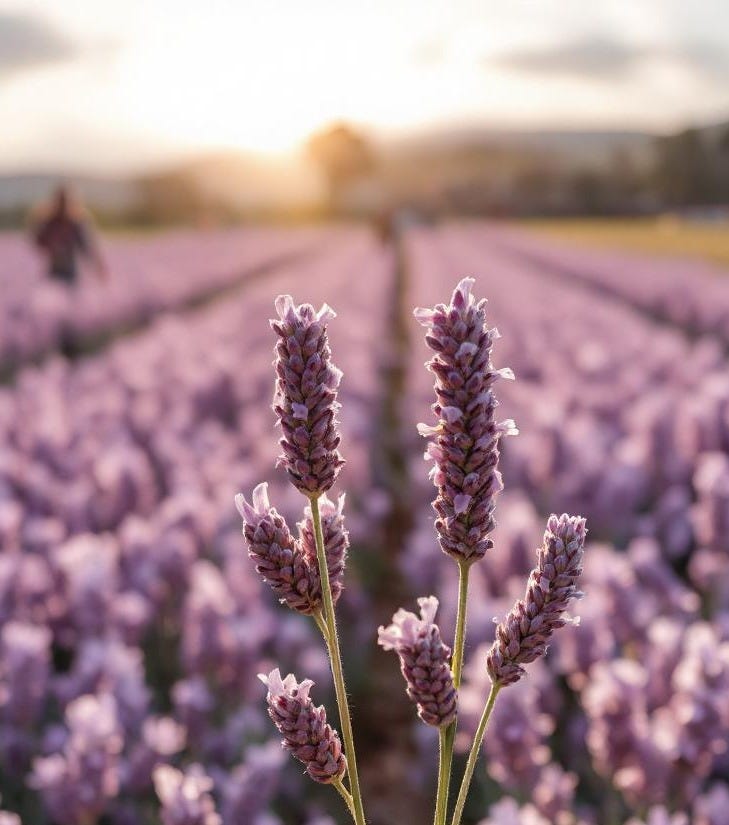






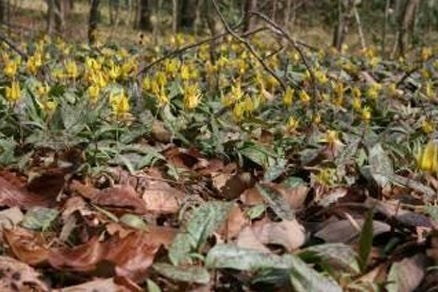


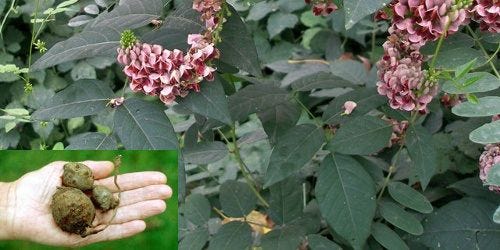


Thank you so much Monica! I wish I'd have listened to my Great Grandma Sophia when she patiently tried to tell me and the others. My Grandma was a beautiful Cherokee lady!
I’ll take a regular salad please!